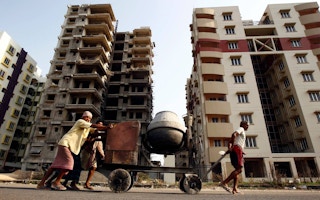India’s top builders have pledged to make at least a fifth of their new housing developments sustainable by 2022, as the country looks to tap sectors other than renewable energy to meet its ambitious climate goals.
The campaign is led by the Sustainable Housing Leadership Consortium (SHLC) comprising builders Godrej Properties, Mahindra Lifespaces, Shapoorji Pallonji, Tata Housing and VBHC Value Homes. It is backed by the Ministry of Housing.
Builders will use mainly local and recycled material, and design homes that conserve water and electricity and make best use of natural light and wind patterns, while also pursuing more energy-efficient methods of construction.
“
Our long-term goal is to make green homes 100 per cent of the industry portfolio. We see green homes becoming the default choice.
Jaimin Desai, head of design and sustainability, Mahindra Lifespaces
“The construction industry has one of the biggest carbon footprints, so it’s really important for us to take action to minimise the impact,” said Jaimin Desai, head of design and sustainability at developer Mahindra Lifespaces.
“This initiative pushes us to incorporate sustainability right from the selection of the site to the design, the use of materials and in increasing awareness in the industry, as well as among our clients,” he told the Thomson Reuters Foundation.
India is the world’s third-biggest emitter of greenhouse gases that cause global warming.
As a signatory to the 2015 Paris Agreement on climate change, India is committed to reducing its carbon emissions by a third by 2030.
It is doing so with tougher emission norms, more electric vehicles and giant solar power plants to replace energy generated by coal.
The real-estate sector is responsible for nearly a quarter of the country’s carbon dioxide emissions. Those emissions come mainly from energy-intensive processes in making construction materials such as steel, cement and bricks.
As India’s economy grows at a fast clip, demand for homes, offices, roads, airports and factories is also rising.
The demand for homes is particularly acute: in urban areas alone, there is a shortage of about 20 million homes.
Prime Minister Narendra Modi has made affordable housing a priority, with incentives such as subsidised loans to meet a 2022 target of “Housing for All”. This has led to a boom in construction across the country.
The effort by SHLC - an initiative of the World Bank’s International Finance Corporation under the eco-cities programme of the European Union - will add 110 million sq ft of green housing by 2020.
Green homes the norm?
While “green” homes were built at a premium earlier and therefore had a niche appeal, newer technologies and greater demand have narrowed the cost differential between them and traditional housing to “almost nothing” now, Desai said.
Developers and buyers are also able to tap financing more easily for sustainable projects, as banks and investors look beyond renewable energy. The SHLC campaign is backed by HDFC Bank and PNB Housing Finance.
“India has huge funding requirements in … sustainable housing, metro rail networks, urban waste management and infrastructure development, that can be met through green financing options,” said Sanjeev Jha, India head of Global Capital Markets at Bank of America Merrill Lynch.
India, a relatively new player to green financing, has issued nearly $4.5 billion worth of green bonds so far, he said.
For homeowners, green homes will create savings of 198 million kWh per year in electricity consumption, and 108 billion litres in water savings, according to SHLC.
This will reduce India’s carbon footprint by approximately 0.2 million metric tons of carbon dioxide, it estimates.
“Our long-term goal is to make green homes 100 per cent of the industry portfolio,” Desai said.
“We see green homes becoming the default choice.”
This story was published with permission from Thomson Reuters Foundation, the charitable arm of Thomson Reuters, that covers humanitarian news, women’s rights, trafficking, property rights, climate change and resilience. Visit news.trust.org to see more stories.










